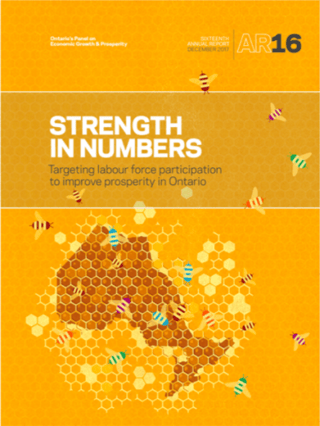 In its 16th Annual Report, Strength in numbers: Targeting labour force participation to improve prosperity in Ontario, Ontario’s Panel on Economic Growth & Prosperity analyzes Ontario's GDP per capita compared to ten similar peer jurisdictions (Ohio, Wisconsin, Indiana, the Netherlands, Tennessee, Sweden, Michigan, Australia, British Columbia, and Québec) and analyzes the labour force participation rate of youth, women, older workers, and Indigenous Peoples in Ontario.
In its 16th Annual Report, Strength in numbers: Targeting labour force participation to improve prosperity in Ontario, Ontario’s Panel on Economic Growth & Prosperity analyzes Ontario's GDP per capita compared to ten similar peer jurisdictions (Ohio, Wisconsin, Indiana, the Netherlands, Tennessee, Sweden, Michigan, Australia, British Columbia, and Québec) and analyzes the labour force participation rate of youth, women, older workers, and Indigenous Peoples in Ontario.
The analysis reveals that Ontario continues to experience a ‘prosperity gap’ – GDP per capita is $5,600 below its peer jurisdictions.
Removing the barriers faced by these four groups has the potential to close Ontario's prosperity gap and could add $54.0 billion to the economy.
Youth have very poor employment outcomes as they struggle to get a foot in the door at their first job. The Panel focused on 15 to 29-year-old non-students to capture only those who are not currently enrolled in education or training to prepare for later entry into the labour market. This group should be entering the labour force at a higher rate than observed.
Women make up the greatest share of the population of any underperforming demographic group. In Ontario, women make up 51 percent of the 15 to 64-year-old population, but a significant portion remain outside the labour market, often due to family or caregiving responsibilities.
Older workers over the age of 55 participate in the labour force to a lesser degree than those in leading OECD countries. As a sizable portion of the population approaches retirement age the labour force will become smaller, while the share of people dependent on government services increases. Finding ways to retain older workers in the labour force will slow the adaptation necessary to care for this segment.
Indigenous Peoples have drastically lower participation rates and outcomes than their non-Indigenous counterparts. Despite their relatively small population size compared to the other three groups selected, reconciliation and improving Indigenous labour force outcomes is of importance to Ontario's Panel on Economic Growth and Prosperity.
Recommendations from the report on reducing barriers to participation include:
- Expanding targeted employment services for older workers and Indigenous Peoples.
- Implementing an affordable child care model and balanced parental leave policy.
- Incentivizing on-the-job training in private firms.
- Taking action on reconciliation with Indigenous Peoples.
- Expanding labour market data to better identify barriers to participation in Ontario.
Report overview reposted from: https://www.competeprosper.ca/work/annual-reports/strength-in-numbers-labour-force-participation-prosperity-Ontario
Learn More:





